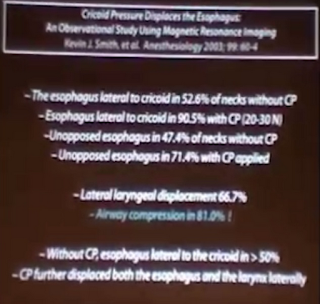This is adapted from a comment I left in response to an excellent Broome Docs post on RSI updates
 |
| BURP vs burp |
Put simply:
Sellick: pressure on cricoid
BURP: assistant puts backwards-upward-rightward pressure on thyroid cartilage
ELM: laryngoscopist moves around the thyroid cartilage with their right hand, in any direction
As mentioned in the Broome Docs post, the goal of Sellick is to prevent gastric insufflation and passive regurgitation, while BURP and ELM are laryngoscopy aides; as also discussed at Broome Docs, Sellick is likely: useless for it's intended goal; often worsens your glottic view; and, may impair tube delivery. Therefore, I've taken it off my radar as there's enough more important things for us all to think about during airway management.
I think of BURP as a "good guess" at the optimal movement (I would guess about 60% accurate).
The technique I learned from Reuben Strayer is to have the assistant put their hand on the thyroid cartilage; the laryngoscopist then moves assistant's hand AND therefore the thyroid cartilage in any/every direction until the view is optimized; the laryngoscopist can then remove their hand, leaving the assistant holding the thyroid in the correct place.
Reuben discusses this (briefly) in his excellent airway lecture just before the 27 min mark.
One note on nomenclature:
Some people have called this "bimanual laryngoscopy" (including Levitan; reference in the comments below); others use that term to describe the laryngoscopist moving the patient's head during laryngoscopy.
I don't know if I'm right or not, but I think of BOTH of those maneuvers (ELM + head mobilization) as bimanual laryngoscopy, as they are both activities that the laryngoscopist does with their right hand -- conceptually, that makes me think of both of those very helpful maneuvers together instead of as separate entities.
It's also a gentle reminder that to use 2 hands on the thyroid cartilage (and oftentimes large-headed patients might need an extra hand under the head as well!).
 |
| Euler Diagram (evidently slightly different than a Venn) |
Update: Two slides from Rich Levitan's Grand Rounds:
 |
| cricoid pressure = bad |
 |
| BL > BURP > CP |
Great post - I think this is a good reminder how we should practice medicine in general. Dont' just do something blindly because that's how we were taught to do it. Make adjustments on the fly and do what is best for your patients.
ReplyDeleteHere's an article comparing nothing/Sellick/BURP/Laryngeal manipulation - written by Mr. Airway himself - Dr. R. Levitan http://www.sciencedirect.com/science/article/pii/S0196064406000709
Great point and great reference!
Deleteso I finally got around to asking Reuben where he got the idea to have an assistant passively place their hand on the patient's thyroid cartilage while the laryngoscopist manipulates the airway, and although I thought he was the one who told me about it (Airway Day 2009?) he doesn't think he ever learned/taught/knew about that. Oddly, Levitan doesn't talk about that either. I certainly didn't come up with it...
ReplyDeleteit is how the maneuver is taught in the emergency airway course
ReplyDeleteah that makes sense. thanks!
DeleteIt is exactly what I teach it to my students!! It is just the alignment of the secondary curve of Keith Greenland and the visualization axis. It evolves a new concept of how direct (not video) laryngoscopy works.
DeleteMinh Le Cong of prehospitalmed.com found this great recent article, comparing CP to jaw thrust. guess who wins (hint: not CP):
ReplyDeleteJ Anesth. 2012 Jun;26(3):362-8. Epub 2012 Mar 13.
Effect of jaw thrust and cricoid pressure maneuvers on glottic visualization during GlideScope videolaryngoscopy.
Corda DM, Riutort KT, Leone AJ, Qureshi MK, Heckman MG, Brull SJ.
http://www.ncbi.nlm.nih.gov/pubmed/22410965
Another reference by Minh:
ReplyDeletehttp://sarhueh.blogspot.com.au/2012/04/propos-de-la-manoeuvre-de-sellick.html
Some MRI data supporting CP
more data on CP worsening view: http://www.annemergmed.com/article/S0196-0644(12)01712-X/abstract
ReplyDeleteGreat post! Congratulations!
ReplyDeleteAre you the author of this Euler Diagram? If so, can I use a version of it in a lecture?
Yep I made that. Feel free to use with attribution
ReplyDeleteRCT in JAMA: no less aspiration with cricoid (low rate), worse view https://jamanetwork.com/journals/jamasurgery/fullarticle/2708019
ReplyDelete*JAMA Surg, sorry
Delete